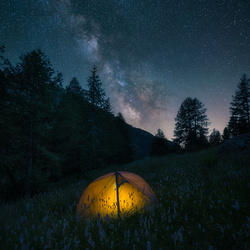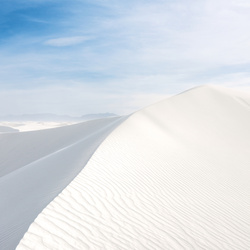A night out in Joshua Tree National Park. I have come to a point in which I want the cleanest image possible when shooting Milky Way landscapes. A single image just is not noiseless enough for me when printing large. I now track and stack 10+ sky images and combine them with a sunrise or sunset blue hour image for a virtually noise free image. This works out wonderfully when printing larger than 18 inches on the long end. I always combine night skies with foregrounds from the same outing, and never do I put the MW in a foreground orientation that doesn't make sense.
Fuji X-T2
Sky = 15 images track/stack with Rokinon 21mm
Ground = single image with Fuji 10-24.
All post done in Photoshop.
















Hello Ryan. Nice work. Very clean and beautifull low noise result.
Also I increasingly have this approach, and one of the biggest challenges for me in this type of photos is to achieve a clean image with a low noise level. My workflow has also been adapted and I came to the same conclusion: tracking + stacking to the sky, and whenever possible and the composition is worth, a single exposure of the foreground in golden or blue hour.
I am currently trying to improve the techniques that are involved in this workflow, especially which have better results in conjunction with post processing, and I still have some doubts
You say you always put the Milky Way in the same position and frame, but that doesnt mean you have to leave the camera and the tripod in the exact same position all the way, right? Do you shoot in different moments and positions, and then use, for example, the auto-align in photoshop for a better possible result?
First of all, I never use golden hour images. The light is still strong enough to cast heavy shadows, and I don't like the way the foreground looks. Blue hour has just enough light to make a clean foreground at ISO 200, but doesn't have the harsher shadows that golden hour has.
I usually spend 3-5 hours imaging the sky. I get many of my foreground images from different locations within the same area I shot my sky. I use those foregrounds to composite in my sky.
As far as MW position. I would never place the MW in a position that is out of place from a recognizable foreground. Fore instance, many people that have been to Joshua Tree would probably recognize this specific location, so I placed the MW in an orientation that you'd naturally see it in if you were there for the night. If the foreground is random and not a unique-ish scene, then I may orient the MW to my liking.
Thanks dude, for the insights. It is more or less the way I think about the optimal workflow for shooting MW astro-landscape photos. Cheers.
I get stacking - is track/stack to trace the motion of the stars/galaxy?
Yeah...stacking tracked images would be next level. If you stack 10 images without a tracker, you're getting about 1-3 minutes of total imaging, depending on the shutter speed of each image. There will be reduced noise, but still visible noise zoomed in or printing large. When you stack 10+ images that are tracked for 1-3 minutes each, you get 10-30+ minutes of imaging. There is very little post production needed on the sky. The colors are rich, vibrant, and pop almost all on their own. Dust lanes are clear, and the great thing, there is virtually no noise zoomed in 100%.
Uff - I've always admired but never done/fully understood star photography - if you aren't tracking the movement, how do you mitigate blue on longer exposures? (maybe stars don't move as much in 30s as I think they do)
Sorry, I don't think I understand your question. Once the stars come out in a dark sky location, there is no blue to mitigate. The sky is black.
Sorry, typo, how do you mitigate blur haha
I'll send you a PM, because these miniature reply threads are killing me. lol
Perfect white balance. Great comp well done
HI, just spotted this posting. From what I understand you took the foreground at the blue hour and stacked (tracked) 15 milky way images? If this is correct what tracking device did you use? Stunning photograph Ryan.
Thanks. Yes. I did it as you described. I used an iOptron Sky Tracker Pro, ($300 on Amazon, i think).
One last question. So how did you process the rocks afterwards. Ie did you shoot the rocks in blue hour then separately took (without the rocks) the milky way and photoshopped the rocks back in? I am struggling with an image that I took at the blue hour of a tree and want to put the mw back in. Any advice would be appreciated.
Yes.